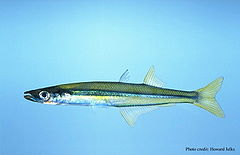Old World silverside: Difference between revisions
fossil range, conversion templates, & inline ref |
GrahamBould (talk | contribs) Fix link |
||
| Line 16: | Line 16: | ||
The '''Old World silversides''' are a [[family (biology)|family]], '''Atherinidae''', of [[fish]] in the order [[Atheriniformes]]. They occur worldwide in tropical and temperate waters. About two thirds of the species are marine, and the remainder live in fresh water. |
The '''Old World silversides''' are a [[family (biology)|family]], '''Atherinidae''', of [[fish]] in the order [[Atheriniformes]]. They occur worldwide in tropical and temperate waters. About two thirds of the species are marine, and the remainder live in fresh water. |
||
Silversides are relatively small, with the largest species, the [[ |
Silversides are relatively small, with the largest species, the [[jacksmelt]], ''Atherinopsis californiensis'', reaching {{convert|44|cm|in}}<ref name=EoF>{{cite book |editor=Paxton, J.R. & Eschmeyer, W.N.|author= Allen, Gerald R.|year=1998|title=Encyclopedia of Fishes|publisher= Academic Press|location=San Diego|pages= 153-154|isbn= 0-12-547665-5}}</ref>, while most are under {{convert|20|cm|in}}, and several are not recorded at more than {{convert|5|cm|in}}. The body is generally elongate. Distinctive characters include two [[dorsal fin]]s widely separated, with the first consisting of flexible spines and the second having one spine followed by soft rays, while the [[anal fin]] has one spine on the leading edge followed by soft rays. The [[pectoral fin]]s tend to be high, and there is no [[lateral line]]. On the flanks there is a broad silvery band. The [[scale (zoology)|scale]]s are relatively large. |
||
They feed on [[zooplankton]]. Some species, such as the [[ |
They feed on [[zooplankton]]. Some species, such as the [[hardyhead silverside]], ''Atherinomorus lacunosus'', are commercially fished. |
||
The family [[Atherinopsidae]] ([[neotropical silverside]]s) is closely related. |
The family [[Atherinopsidae]] ([[neotropical silverside]]s) is closely related. |
||
Revision as of 20:02, 26 November 2008
| Old World silverside Temporal range: [1]
| |
|---|---|

| |
| Labidesthes sicculus | |
| Scientific classification | |
| Kingdom: | |
| Phylum: | |
| Class: | |
| Order: | |
| Family: | Atherinidae
|
| Genera | |
|
See text | |
The Old World silversides are a family, Atherinidae, of fish in the order Atheriniformes. They occur worldwide in tropical and temperate waters. About two thirds of the species are marine, and the remainder live in fresh water.
Silversides are relatively small, with the largest species, the jacksmelt, Atherinopsis californiensis, reaching 44 centimetres (17 in)[1], while most are under 20 centimetres (7.9 in), and several are not recorded at more than 5 centimetres (2.0 in). The body is generally elongate. Distinctive characters include two dorsal fins widely separated, with the first consisting of flexible spines and the second having one spine followed by soft rays, while the anal fin has one spine on the leading edge followed by soft rays. The pectoral fins tend to be high, and there is no lateral line. On the flanks there is a broad silvery band. The scales are relatively large.
They feed on zooplankton. Some species, such as the hardyhead silverside, Atherinomorus lacunosus, are commercially fished.
The family Atherinopsidae (neotropical silversides) is closely related.
Classification
The family Atherinidae contains about 165 species, grouped into 25 genera, including the following:[2]:
- Alepidomus
- Atherina
- Atherinason
- Atherinomorus
- Atherinosoma
- Atherion
- Craterocephalus
- Hypoatherina
- Kestratherina
- Labidesthes
- Leptatherina
- Menidia
- Poblana
- Stenatherina
- Teramulus
References
- ^ a b Allen, Gerald R. (1998). Paxton, J.R. & Eschmeyer, W.N. (ed.). Encyclopedia of Fishes. San Diego: Academic Press. pp. 153–154. ISBN 0-12-547665-5.
{{cite book}}: CS1 maint: multiple names: editors list (link) - ^ Froese, Rainer, and Daniel Pauly, eds. (2008). "Atherinidae" in FishBase. November 2008 version.
- Froese, Rainer, and Daniel Pauly, eds. (2005). "Atherinidae" in FishBase. November 2005 version.
